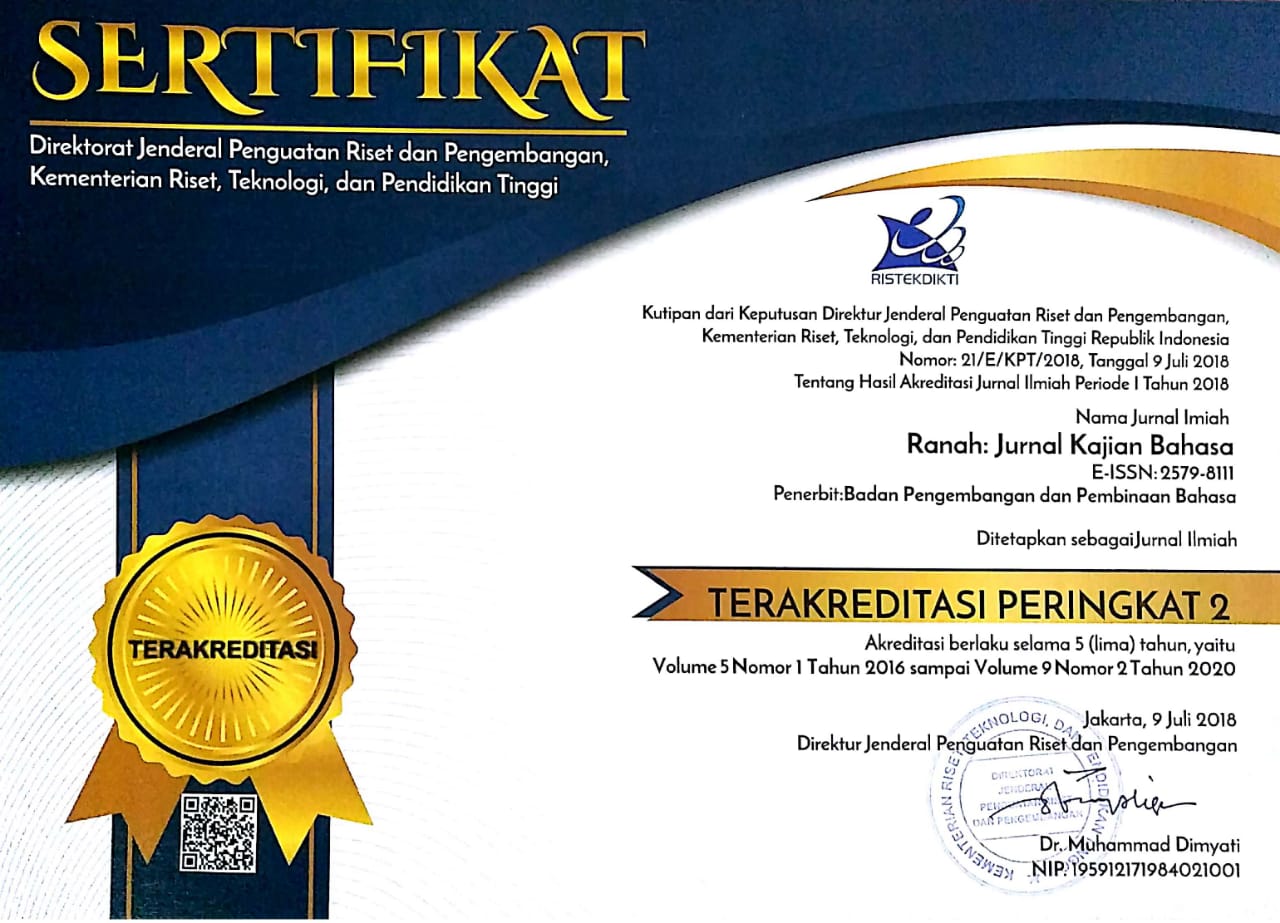Sebuah Reviu terhadap Kajian Partikel Pragmatik dalam Beberapa Bahasa Daerah di Indonesia
Abstract
This paper aims to demonstrate studies of pragmatic particles in Indonesian vernacular languages. Given the fact that Indonesia ranked second most populated language in the world after New Guinea, we would expect a huge number of studies discussing Indonesian local languages. Review to studies of pragmatic particles in Indonesian language is therefore considered salient to carry out to shed light on how different authors examine different particles, what kind of method they employ to describe meaning and functions, and what potential implication this study could contribute in this field. Besides, it also enriches the cross-linguistic study of pragmatic particles in general. Following Macaro et al’s. (2017) guideline of systematic review, this study employed linear process of procedure by deciding keywords, screening title, reviewing abstract, examining full text, and drawing conclusion. The corpus of pragmatic particles employed in reviewed studies ranges from colloquial, spoken, dialogue, and monologue data. Some approaches were used to reveal the pragmatic meanings, such as conversation analysis approach, pragmatics, morpho-syntactic, and even phonological approach. This discussion in the present paper may be fruitful for researchers who are working on pragmatic particles or vernacular languages and suggests that more studies in local languages should be outstripped to sustain national linguistic identity in the global arena.
Abstrak
This paper aims to demonstrate studies of pragmatic particles in Indonesian vernacular languages. Given the fact that Indonesia ranked second most populated language in the world after New Guinea, we would expect a huge number of studies discussing Indonesian local languages. Review to studies of pragmatic particles in Indonesian language is therefore considered salient to carry out to shed light on how different authors examine different particles, what kind of method they employ to describe meaning and functions, and what potential implication this study could contribute in this field. Besides, it also enriches the cross-linguistic study of pragmatic particles in general. Following Macaro et al’s. (2017) guideline of systematic review, this study employed linear process of procedure by deciding keywords, screening title, reviewing abstract, examining full text, and drawing conclusion. The corpus of pragmatic particles employed in reviewed studies ranges from colloquial, spoken, dialogue, and monologue data. Some approaches were used to reveal the pragmatic meanings, such as conversation analysis approach, pragmatics, morpho-syntactic, and even phonological approach. This discussion in the present paper may be fruitful for researchers who are working on pragmatic particles or vernacular languages and suggests that more studies in local languages should be outstripped to sustain national linguistic identity in the global arena.
Keywords
Full Text:
PDFReferences
Abraham, W. (1991). Discourse Particles in German: How does Their Illocutive Force Come about? In Abraham, W (Ed.). Discourse Particles. Amsterdam: Benjamins, 203-252. https://doi.org/10.1075/pbns.12.08abr
Aijmer, K., & Simon-Vandenbergen, A. (2003). The discourse particle well and its equivalents in Swedish and Dutch. Linguistics, 41(6), 1123-1161. https://doi.org/10.1515/ling.2003.036
Brinton, L. J. (1996). Pragmatic Markers in English: Grammaticalization and Discourse
https://doi.org/10.1515/9783110907582
Functions. Berlin: Mouton de Gruyter. https://doi.org/10.1515/9783110907582
Davies, W. D. (2010). A Grammar of Madurese. Berlin: De Gruyter Mouton. https://doi.org/10.1515/9783110224443
Fitriani, R.S. (2015). Kesantunan Tuturan Imperatif Siswa SMK Muhammadiyah 2 Bandung: Kajian Pragmatik. Politeness of Imperative Acts of SMK Muhammadiyah 2 Bandung" A Pragmatic Study Indonesian. Ranah: Journal Kajian Bahasa, 4(1), 34-46. https://doi.org/10.26499/rnh.v4i1.23
Foolen, A. (2011). Pragmatic Markers in Socio-pragmatic Perspective. Gisle Andersen & Karin Aijmer (eds.) Pragmatics of Society. Berlin: De Gruyter Mouton, 217-242. https://doi.org/10.1515/9783110214420.217
Foolen, A. (1995) Dutch Modal Particles: The Relevance of grammaticalized Elements. In: Thomas F. Shannon & Johan P. Snapper (Ed.). The Berkeley Conference on Dutch Linguistics 1993, 57-70.
Fraser, B (1988). Types of English Discourse Markers. Acta Linguistica Hungaria, 38, 383-395.
Fraser, B. (1990). An approach to discourse markers. Journal of Pragmatics, 14(3), 383-398. https://doi.org/10.1016/0378-2166(90)90096-V
Grice, H. P. (1975). Logic and Conversation. In Cole, P., & Morgan, J. L. (Ed). Speech Acts. New York: Academic Press, 41-58. https://doi.org/10.1163/9789004368811_003
Gupta, A. F. (1992). The pragmatic particles of Singapore colloquial English. Journal of Pragmatics, 18(1), 31-57. https://doi.org/10.1016/0378-2166(92)90106-L
Han, D. (2011). Utterance production and interpretation: A discourse-pragmatic study on pragmatic markers in English public speeches. Journal of Pragmatics, 43(11), 2776-2794. https://doi.org/10.1016/j.pragma.2011.04.008
Halliday, M. A. K., & Hasan, R. (1976). Cohesion in English. London: Longman.
Hayashi, M. (2010). An overview of the question-response system in Japanese. Journal of Pragmatics, 42(10), 2685-2702. https://doi.org/10.1016/j.pragma.2010.04.006
Holmes, J. (1986). Functions of "You Know" in Women's and Men's Speech. Language in Society, 15(1), 1-21. https://doi.org/10.1017/S0047404500011623
Irham. (2015). Pragmatic Particles in Madurese: A Corpus Study of Jâ' in Oral Narrative and Conversations. Unpublished Thesis. Radboud University Nijmegen, the Netherlands.
Irham, I. (2018). Evaluating the Pragmatic Particle Jâ' in A Madurese Spoken Corpus. Indonesian Journal of Applied Linguistics. https://doi.org/10.17509/ijal.v7i3.9814
Irham & Rofiq, Z. (2015). Tense and Aspect in Madurese: Projecting Davies' work on Grammar of Madurese. Published in the proceeding of International Conference on Interdisciplinary Social Science Studies. London, (pp. 5-12),
Ikranagara, K. (1975). Lexical Particles in Betawi. Linguistics, 13(165), 93-108. https://doi.org/10.1515/ling.1975.13.165.93
Johansson, S. (2006). How well can well be Translated? On the English discourse particle well and its correspondence in Norwegian and German. In K. Aijmer, & A. Simon-Vandenbergen (Eds.), Pragmatic markers in contrast. Studies in pragmatics 2 (pp. 115-137). Amsterdam, the Netherlands: Elsevier.
Klok, J. V. & Matthewson, L. (2015). Distinguishing already from perfect aspect: A case study on Javanese wis. Oceanic Linguistics, 54, 1, 172-205. https://doi.org/10.1353/ol.2015.0007
König, E. (1991). Identical Values in Conflicting Roles: The Use of German Ausgerechnet, Eben, Genau, and Gerade as Focus Particles. In Werner Abraham (Ed.). Discourse Particles. Amsterdam: Benjamins, 11-36.
Kulsum, U. (2012). Iya deh atau Iya Dong ?: Membandingkan Partikel Fatis deh dan dong dalam Bahasa Indonesia Iya deh or Iya dong ?: Comparing Phatic Particles deh and dong in Indonesian. Ranah: Journal Kajian Bahasa, 1, 40-55. https://doi.org/10.26499/rnh.v1i1.15
Labov, W., & Fanshel, D. (1977). Therapeutic Discourse: Psychotherapy as Conversation. New York: Academic Press.
Macaro, E., Curle, S., Pun, J., An, J., & Dearden, J. (2018). A systematic review of English medium instruction in higher education. Language Teaching, 51(1), 36-76. https://doi.org/10.1017/S0261444817000350
Miles, M. B., Huberman, A. M., & Saldaña, J. (2014). Qualitative data analysis: A methods sourcebook. Los Angeles: Sage publication.
Müller, S. (2005). Discourse markers in native and non-native English discourse. Amsterdam: John Benjamins. https://doi.org/10.1075/pbns.138
Östman, J-A. (1995). Pragmatic particles twenty years after. Organization in discourse. Proceedings from the Turku conference. In B. Warvik, S-K Tanskanen, & R. Hiltunen (Eds.). Anglicana Turkuensia, 14, 95-108.
Östman, J-A. (2006). Constructions in cross language research: Verbs as pragmatic particles in Solv. In K. Aijmer, & A. Simon-Vandenbergen (Eds.), Pragmatic markers in contrast. Studies in pragmatics 2 (pp. 237-257). Amsterdam: Elsevier.
Sari, F. (2007). Pragmatic particles: A cross-linguistic discourse analysis of interaction. Unpublished dissertation, the University of Alabama. USA.
Schiffrin, D. (1987). Discourse Markers. Cambridge: Cambridge University Press. https://doi.org/10.1017/CBO9780511611841
Schourup, L. C. (1985). Common Discourse Particles in English Conversation. New York: Garland.
Sofyan, A. (2007). Beberapa Keunikan Linguistik Bahasa Madura. Humaniora, 19(3), 232-240.
Stevens, A. M. (1968). Madurese Phonology and Morphology. New Haven: American Oriental Society.
Uhlenbeck, E. M. (1964). A critical survey of studies on the languages of Java and Madura: Bibliographical series 7. Dordrecht: Springer Netherlands. https://doi.org/10.1007/978-94-011-8790-9
van der Wouden. T., & Foolen, A. (2015). Dutch particles in the Right Periphery. In Hancil, S., Haselow, A., and Post, M. (Ed.). Final Particles. Berlin: De Gruyter Mouton, 221-247
Wierzbicka, A. (1991). Cross-cultural Pragmatics. The Semantics of Human Interaction. Berlin: Mouton de Gruyter.
Wolff, J. U. (1980). Beginning Indonesian: Part 1. Ithaca, N.Y: Cornell University, Southeast Asia Program.
Wouk, F. (1998). Solidarity in Indonesian Conversation: The Discourse Marker kan. Multilingua, 17(4), 379-406. https://doi.org/10.1515/mult.1998.17.4.379
Wouk, F. (1999). Gender and the use of pragmatic particles in Indonesian. Sociolinguistics, 3(2), 194-219. https://doi.org/10.1111/1467-9481.00072
https://doi.org/10.1111/1467-9481.00072
Wouk, F. (2001). Solidarity in Indonesian conversation: The discourse marker ya. Journal of Pragmatics. https://doi.org/10.1016/S0378-2166(99)00139-3
https://doi.org/10.1016/S0378-2166(99)00139-3
Wouk, F. (2008). The syntax of intonation units in Sasak. Studies in Language, 32. https://doi.org/10.1075/sl.32.1.06wou
Wouk, F., & Arafiq. (2016). The Particle kai in Bimanese. Oceanic Linguistics, 55, 2, 319-349. https://doi.org/10.1353/ol.2016.0016
Yoon, K. E. (2010). Question-Response Sequences in Conversation across Ten Languages. Journal of Pragmatics, 42(10), 2782-2798. https://doi.org/10.1016/j.pragma.2010.04.012
Yuniar, D., Sujatna, E.T., & Heriyanto. (2013). Discourse Markers in Sundanese Oral Narrative. LiNGUA, 8 (2), 170-173.
DOI: https://doi.org/10.26499/rnh.v9i1.1411
Refbacks
- There are currently no refbacks.








